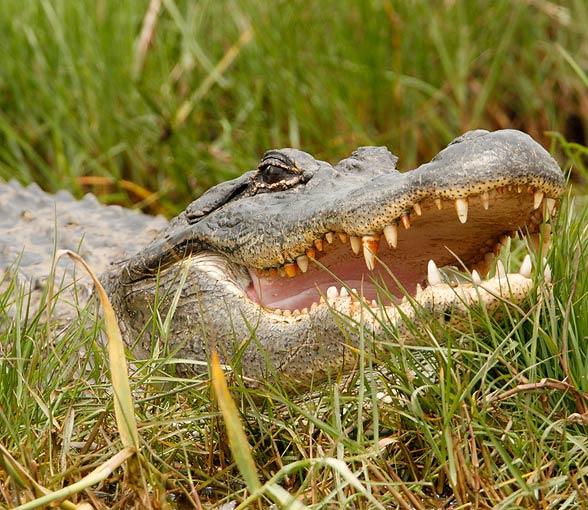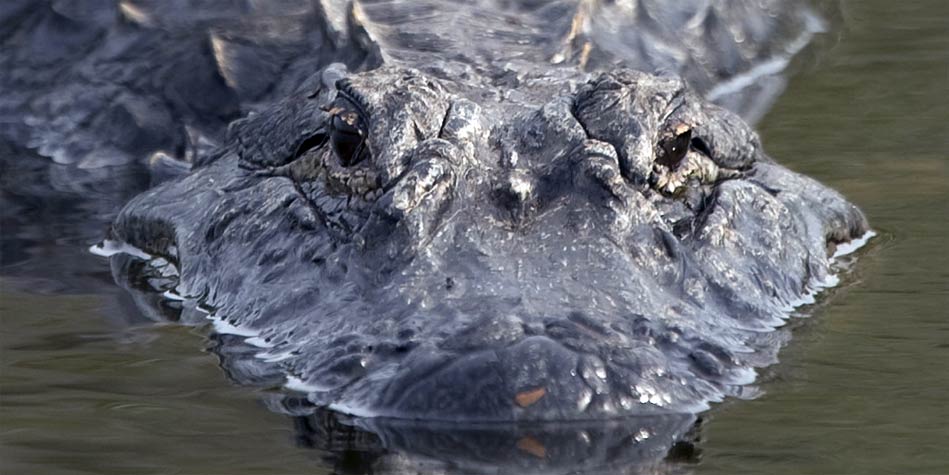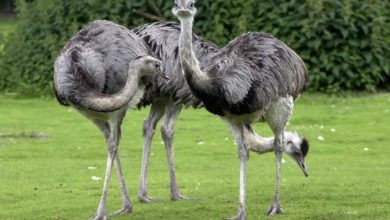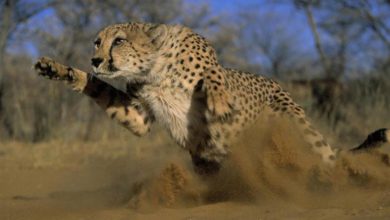American alligator vs Chinese alligator
American alligator and Chinese alligator – comparison, similarities and differences
Alligators are closely related to crocodiles and caimans. For the untrained eye, they are almost indistinguishable from crocodiles. However, unlike their cousins, the alligators only swim in fresh waters. They are not as widespread in the world as their relatives.
Classification
- Kingdom: Animalia
- Phylum: Chordata
- Class: Reptilia
- Order: Crocodilia
- Family: Alligatoridae
- Genus: Alligator
Modern classification encompasses only two species:
- American alligator / gator / common alligator (Alligator mississippiensis)
- Chinese alligator / Yangtze alligator (Alligator sinensis)
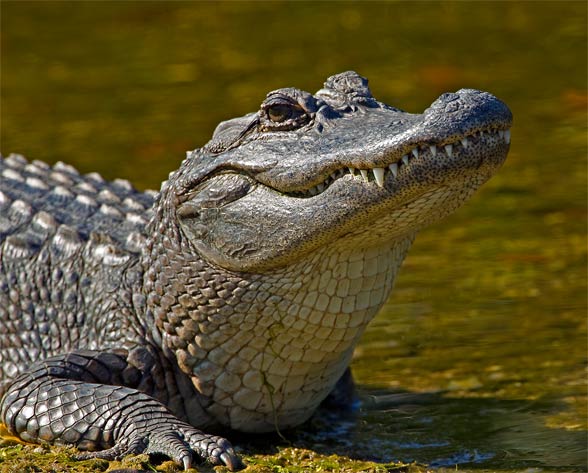
American alligator (Alligator mississippiensis)
Habitats
It occurs in the south-eastern territories of the United States. It inhabits freshwater wetlands, mainly marshes from Texas to North Carolina.
It differs from American crocodile (Crocodylus acutus) by a broader snout and darker coloration. In addition, it does not easily tolerate salt water, but more efficiently than a crocodile adapts to a cool climate.
Size
Adult males measure between 3.4 and 4.6 m (11.2 to 15.1 ft) in length and weight up to 626 kg (1,380 lb); females reach 2.7 – 3 m (8.5 to 9.8 ft) and a weight of approx. 90 kg (200 lb).
Population
The population of American alligator is estimated over 1 million individuals.
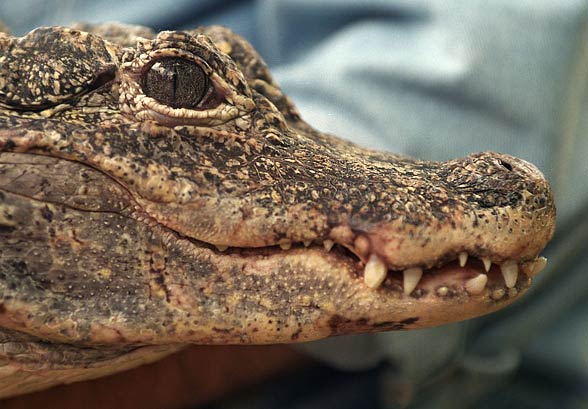
Chinese alligator (Alligator sinensis)
Habitats
It occurs exclusively in Eastern China, in the subtropical and moderate zone. It usually chooses low altitude sites rich in freshwater waters: marshes, lakes, streams and ponds as its habitat. Wetlands are an extremely important habitat due to their biodiversity.
Distribution and population
Originally occupied most of China, but in the 1950’s it was only observed in the southern part of the Changjiang River, to the west coast of Lake Taihu, in the mountainous regions of the province. It usually stayed in lakes, swamps and streams, but in the 1970’s the species was limited to a small area in the southern Anhui and Zhejiang provinces.
In 1998, the largest population lived along the Yangtze River near cultivated fields, including… 11 individuals. In 1999, there were only around 150 Chinese alligators in the wild.
The modern range has been reduced by 90% due to the destruction of habitats for the extension of arable land. Most of the original areas of Chinese alligator occur today as rice fields.
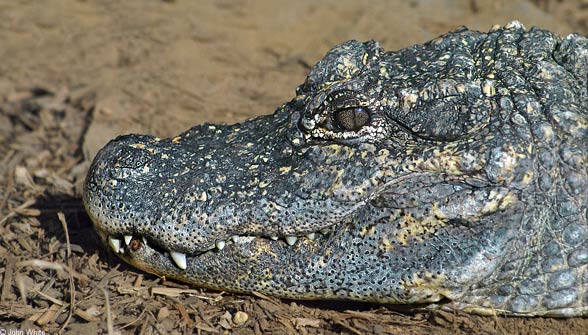
Causes of extinction
Alligators slowly become extinct, because they are getting poisoned by the rats they eat. Moreover, they are often killed by people for meat or because people are afraid of them. Only few Chinese alligator nests have been found in the last decade.
Chinese alligator vs. American alligator
In contrast to a large American alligator, the Chinese alligator is quite small. It is approx. 1.5 m (5 ft) long and weigh around 36 kg (80 lb). Large specimens achieve 2.1 m (7 ft) and 45 kg (100 lb), although there have been mentions about specimens that are supposed to be 3.0 m (10 ft) long. However, it is believed that this information is not true.
The alligator is completely armored (this applies even to the abdomen), which is a feature of only a few species of crocodiles.

Diet
The type of diet depends on the age and size of the individual. Young alligators eat fish, insects, snails, shellfish and worms. When they are growing up, they start to look for bigger preys, including fish (for example Lepisosteiformes), as well as turtles, birds, various mammals (especially coypus and muskrats), deer and other reptiles.
They often have gastroliths (stomach stone or gizzard stones) in their stomach. If Alligator is really hungry, it may eat even the carrion.
Chinese alligators prefer bivalves and snails because their teeth are very well adapted to such type of food.
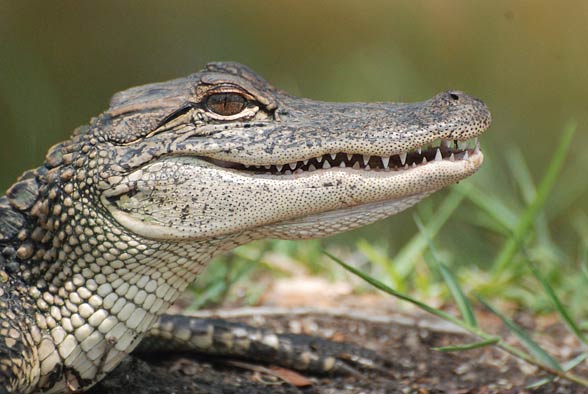
Apex predator
It happened sometimes that bigger American alligators caught dogs, cougars (Puma concolor coryi) and even black bears (Ursus americanus). It indicated that in the territories where they occur, they are apex predators; this means that in the areas of occurrence they are the apex predators regulating populations of other animals, especially turtles and nutria.
Alligators vs. people
In general, alligators are not aggressive towards humans, even if they enter the territory of the reptile. There are only few registered attacks. However, it is better not to provoke them.
The attitude towards people is what distinguishes alligators from crocodiles. Crocodile sees people as potential preys and therefore they attack them immediately. Alligator is more tolerant, provided that it is not provoked.
Hunting methods
They usually hunt for smaller animals, which may be killed with one bite and swallowed as a whole. Bigger prey is caught in the snout and dragged under the water in order to drown. With a large animal, the alligator makes a quick turn around its axis to tear away a portion of meat from the body (similar to a crocodile). In this method, the tail, which has to bend at a large angle, plays a key role. Therefore, if this part of the body is immobilized, the alligator will not perform “lethal rotation”.
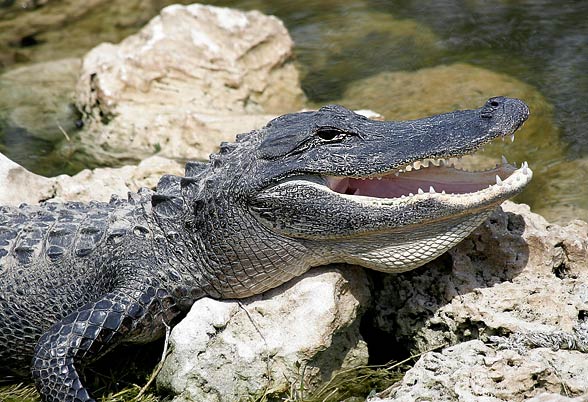
Similarities in behavior: American and Chinese alligator
Adult males are territorial loners. Smaller individuals often live in neighboring areas. Females and males of larger alligator species – American alligator – fiercely guard their territories. Chinese alligators are more tolerant towards the specimens of the same size.
Even though their metabolism is slow and the body is heavy, they are able to achieve relatively high speed at very short distances.
A majority of jaw muscles evolved to be able to bite and attach to the meat, therefore the muscles responsible for closing the jaw are very powerful, while those responsible for opening the jaw are relatively weak. In result, man is able to overpower this reptile with bare hands or with several layers of insulation tape.
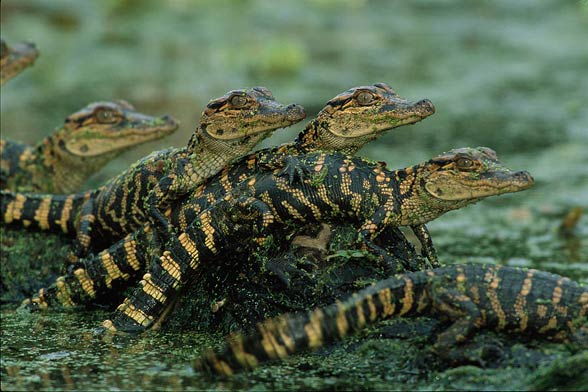
Shy towards people
They are quite shy towards people – they tend to draw back and swim away when somebody approaches them. This behavior prompts some people to approach too close to the nests, and this will definitely end in an attack.
Thinking about people and animals, wild alligators were forbidden to feed in the state of Florida. In this way, the reptilian reptiles lost any respect towards the human being and learned to associate it with food, becoming a real threat to tourists.

Gait (movement method)
On the ground, the American alligator moves on four legs, raising his stomach. However, the way of moving does not resemble a salamander or lizard but is similar to an “ordinary” walk.
The alligator uses 2 forms of locomotion: “low walk” and “high walk”, so unlike other land vertebrates, the alligator increases speed by moving the limbs closer to each other.
In the water, Alligator swims like fish – by moving its pelvis and tail from side to side.
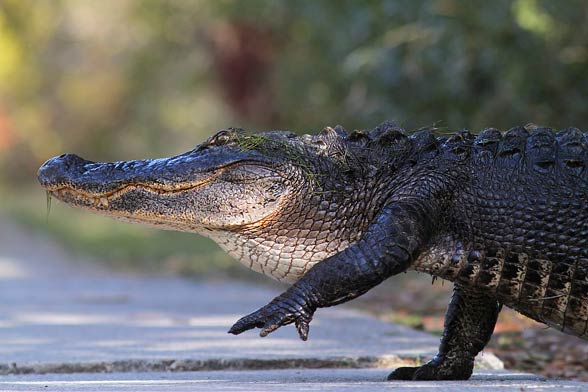
Vocalizations (sounds)
The American alligator vocalizes very often, and the type of sound emitted depends on the sex, size and age of the animal. It can call for help, mark a territory, threaten competitors or call on relevant partners.
Young alligators emit squeaks a moment before hatching. Immature individuals call the mother if they feel endangered.
Although alligators do not have vocal cords, they can roar by sucking air into the lungs and blasting it in a specific way, emitting deep, low roars.
When joining pairs males use infrasound in combination with a characteristic pose in which the head is inclined and the tail is bent. The sound waves are strong enough to cause water tremors (the so-called “water dance”).
Choirs in the breeding season are usually an initiative of females and are supported by voices of males. In addition to the roars, the alligator can growl, hiss or cough when he warns or emphasizes that the territory belongs to it.

Chinese alligator
The Chinese alligator falls into a winter sleep. At that time he lives in burrows built among wetlands. With the advent of spring, the burrow is still used, but much less frequently. She spends most of her time warming up in the sun, thus raising her body temperature. Due to intensive heating, the animal may be active at night. Temperature control is also carried out using water – if it is too warm, it goes to the shade, if it is too cold, it stays in the sun.
The Chinese alligator is considered the gentlest representative of crocodiles.
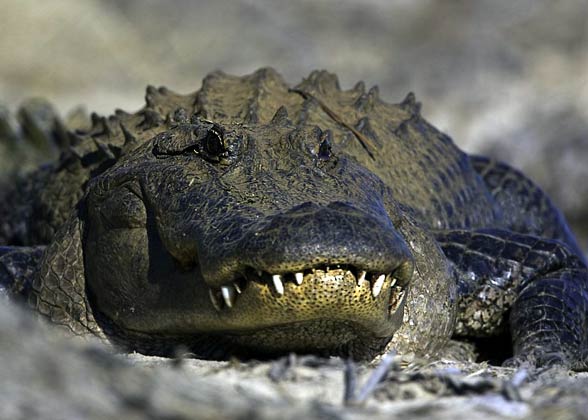
Choruses (mating songs)
Even though the Chinese alligator is usually a loner, it participates in bellowing choruses during the mating season in the spring. Both genders participate in the choruses, which last on average about 10 minutes. They respond very loudly and almost in unison.
Though usually alone, it often participates in collective songs that resound in spring during the mating season. Both sexes participate in the concerts, which last on average 10 minutes, and males and females respond to them unbelievably, even unanimously.
It is therefore suspected that songs are not a form of competition for a partner, but are intended to gather as many individuals as possible in one place. It is also possible that these songs do not serve any purpose.
The smallest egg among crocodiles
Within one clutch there are 20 – 30 eggs and they are probably the smallest eggs among all crocodiles’ eggs.
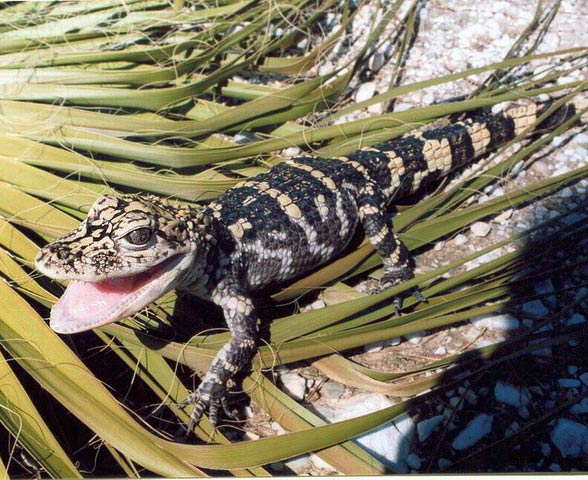
Reproduction
Alligators reach sexual maturity after reaching 1.8 m in length, and mating starts in late spring. In April and May, alligators form the previously described roaring choirs, which can be heard several times a day, 1-3 hours after sunrise.
In summer, females form nests lined with decayed plants that provide the heat needed for egg incubation, as the sex of the future offspring depends on the temperature level. The sex determinates 7 to 21 days after the beginning of incubation.
In the case of the American alligator, the female lays from 20 to 50 eggs, which are being covered. The nest may be over 1 meter (3 ft) high and more than 2 meters (7 ft) wide.
At 30 degrees Celsius (86 °F) or below, females appear in the litter, males hatch at a temperature equal to or higher than 34 degrees Celsius (93 °F). It is a pity that we cannot regulate sex like that …;)
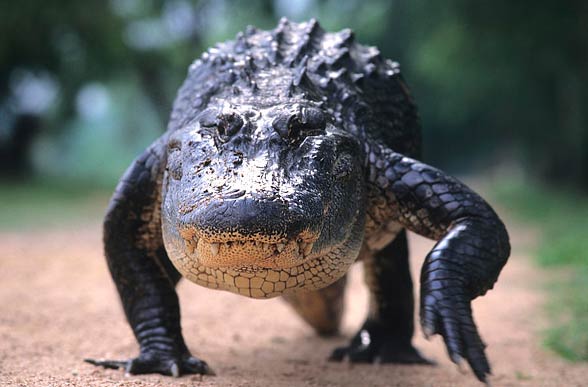
The birth rate of females and males is 5:1 (5 females per 1 male).
The mother fiercely defends the nests from predators, and after hatching the chicks brings them to the water, covering them with care for a period of about a year, although it happens to be a period of two or even three years.
Paradoxically, the biggest threat to young alligators are adult alligators, although nice raccoons also like small alligators.
When alligator hatches the egg, it has so-called egg tooth, which enables it to hatch the eggshell.

Alligators vs crocodiles – comparison: similarities and differences
What is the difference between a crocodile and an alligator?
- Alligators have broader, U-shaped head. Crocodiles have longer and slender head, more like the letter “V”
- A fourth crocodile’s teeth of the lower jaw stick up over the upper lip when its snout is closed. Alligator’s fourth teeth are hidden because its upper jaw is wider than the lower one, so when it closes its mouths, all its teeth are hidden.
- Crocodiles cannot hide their teeth, alligators can sometimes hide their teeth when their snouts are closed
- Adult crocodiles are much larger than alligators.
- On land and in water alligators are faster than crocodiles.
- Alligators swim exclusively in fresh water, while some crocodiles are well adapted to live in the oceans e.g. saltwater crocodiles.
- Crocodiles are more aggressive than
- Alligators have a darker coloration.
- The alligator has longer legs than a crocodile. While walking on land, the alligator lifts the trunk high on the ground, unlike the crocodile.
- Alligators occur naturally only in the United States and China. Crocodiles live in many regions of the world (America, Asia, Africa).
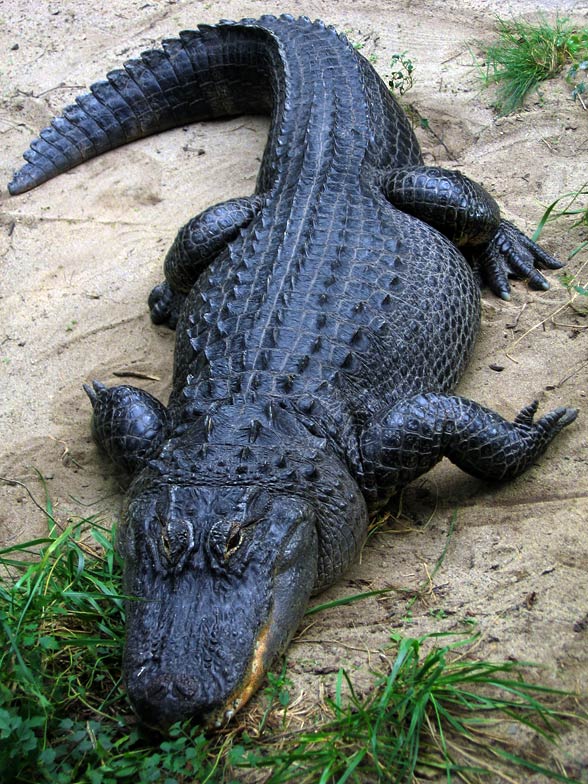
Detailed information and dimensions
Alligators
American alligator (Alligator mississippiensis)
- Body length:
- males: 3.4 to 4.6 m (11.2 to 15.1 ft)
- the largest reported individual was killed in 1890 on Marsh Island, in Louisiana, it measured 5.84 m (19 ft 2 in). If the size of this alligator was correct, it would have weighed around 1,000 kg (2,200 lb)
- the largest American alligator ever killed in Florida was 5.31 m (17 ft 5 in)
- the largest American alligator scientifically verified in Florida for the period from 1977 to 1993 was 4.23 m (13 ft 11 in) long
- females: 2.6 to 3 m (8.5 to 9.8 ft)
- males: 3.4 to 4.6 m (11.2 to 15.1 ft)
- Weight:
- males: on average up to 360 kg (790 lb)
- the biggest American alligator was killed in Arkansas – it was 4.04 m (13 ft 3 in) long and weighted 626 kg (1,380 lb)
- females: up to 91 kg (200 lb)
- males: on average up to 360 kg (790 lb)
- The bite force: 13,172 N (1,343.2 kgf; 2,961 lbf)
- Population of American alligator: over 1 million in the wild
Only saltwater crocodile (16,414 N (1,673.8 kgf; 3,690 lbf)) has more powerful jaws than American alligator. See more about the power of jaws in the article: T.rex – facts and myths
Chinese alligator (Alligator sinensis)
- Body length: 5 – 2.1 m (5 – 7 ft)
- Weight: 36 – 45 kb (80 – 100 lb)
- Population of Chinese alligator: over 150 specimens in the wild
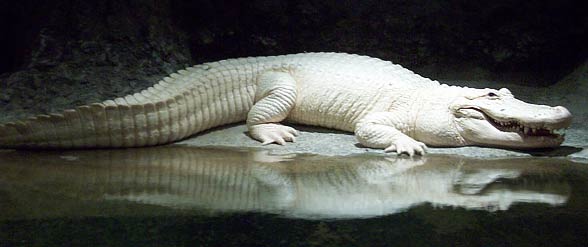
Alligators – curiosities
- The name alligator comes from the Spanish el lagarto, which means “the lizard” – this is how Spanish colonists called those reptiles in Florida.
- Alligators first appeared during the Oligocene epoch about 37 million years ago
- The biggest alligator was shot in Louisiana. It was 15.84 m (19 ft 2 in).
- It is not known how long alligators live. In 1937, a specimen who lives to this day was brought from Germany to the Belgrade ZOO. Although there is no mention of its birthday, it is considered the oldest alligator in captivity. Therefore, it deserved its own name – Muja. At the time it arrived, it was already an adult.
- The roar of an American alligator is louder than the sounds of most crocodiles.
- The mortality rate among young alligators that have not exceeded one year of age is about 50%.
- When the ambient temperature drops below 23 °C (73 °F), alligators stop eating.
